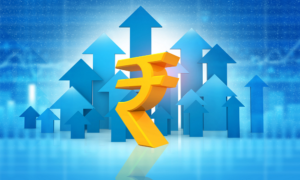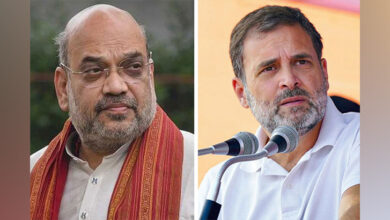Sensex at 80,000: Financial articulation of India’s growth will likely continue
It has taken seven months for the Sensex to stride 10,000 points to close beyond the 80,000-mark, a rise of 14 percent. There is no symmetry in this rise, no predictability of where it will go, not even a probability of sustaining. The only forecast anyone can do about the Sensex is that in the long term, like all other stock indices across the world, it will grow in tandem with its underlying growth of the economy in general and companies in particular. Over the past 12 months, only two large stock markets have delivered returns of more than 20 percent—India (22.3 percent) and Japan (22.7 percent). Germany has risen by 15.1 percent, the United States (US) by 14.6 percent; the United Kingdom (UK), 9.6 percent; Australia, 8 percent; China and Hong Kong are down 8.2 percent and 5.7 percent respectively.
Behind the Sensex—an index that tracks the growth of India’s 30 most most-valued companies on the BSE (formerly, Bombay Stock Exchange)—at 80,000 lie the hopes of more than 36 million investors. At 1.5 million voters per constituency, they approximately comprise the political equivalent of 24 Lok Sabha seats. That investors in markets are scattered across the country makes their political weight statistically insignificant, their voice unheard. But add the more than 277 million employees that get equity exposure of Sensex companies through their provident fund and the 186 million mutual fund folios, and the political weight rises to 509 million investors, the equivalent of almost 340 Lok Sabha seats. Of course, we need to leave room for double counting in the three categories.
Within the Sensex at 80,000 is the aspiration of 5,000-plus companies that are listed on the BSE to join the index. The dynamism of the Sensex, as it is for any other international stock market index, typifies Charles Darwin’s survival of the fittest. The fitness test comprises size and scale, in turn led by, among several other things, growth in profits, hyperjumps of innovation, and liquidity while transacting…all functioning in a dynamic economy. Companies routinely enter and exit the Sensex. Ever since India’s economic reforms began on 24 July 1991 when the Sensex stood at 1,400, only six companies have managed to stay on till Sensex 80,000—Hindustan Unilever, ITC, L&T, Mahindra and Mahindra, Nestle, and Reliance Industries. The most valuable companies of three decades ago such as ACC, Bombay Dyeing and Century Spinning have given way to HDFC Bank, Sun Pharmaceuticals and TCS. In the last change on 24 May 2024, Wipro, the star of the go-go 2000 tech boom, shifted out, and Adani Ports moved in.
Ever since India’s economic reforms began on 24 July 1991 when the Sensex stood at 1,400, only six companies have managed to stay on till Sensex 80,000—Hindustan Unilever, ITC, L&T, Mahindra and Mahindra, Nestle, and Reliance Industries.
But Sensex is not a benchmark of 5,000 companies or half-a-billion investors alone. When companies do well, the notional wealth of promoters, the biggest of which is the government of India, rises. This gives them room to raise more money, build more facilities, expand their businesses and create jobs. There are three government-owned companies in the Sensex—State Bank of India (which has risen 45 percent in the past 12 months), Power Grid Corporation (78 percent), and NTPC (96 percent). Their combined rise is more than INR 446,000 crore (US$53 billion) which has taken their value from INR 996,000 crore (US$119 billion) to INR 1,443,000 crore (US$173 billion). In other words, not only have public sector companies driven the Sensex to 80,000, but the government has been a major beneficiary of this rise. A separate index that tracks 30 central public sector undertakings—BSE CPSE, in which government has more than 51 percent stake—has more than doubled, taking the combined value of its constituents to INR 5,055,055 crore (US$600 billion). This might be a good time for Finance Minister Nirmala Sitharaman to think about announcing more public sector disinvestments in her forthcoming Budget 2024.
A related indicator to look at Indian stock markets is their market capitalisation as a percentage of GDP. This can be seen as one way to assess how much risk money—domestic and international—is embedded into a country’s stock market. In India’s case, this has been rising. It was 58.6 percent in 2004, 101.9 percent in 2009, 82.7 percent in 2014, 80.7 percent in 2019 and stands at 134.2 percent today. This is close to where the US or Japan are, and double than that of Germany or China. Inter-country comparisons are layered and can be tricky, so these numbers are only a pointer. For instance, a fast-growing underlying economy like India, combined with its companies that grow faster than the aggregate, will attract more investors and carry a higher equity premium and valuations than one that’s growing slower.
Risk transformation is the other story that has taken India’s market capitalisation to its highest-ever INR 4,49,88,986 crore or US$5.3 trillion and created wealth for millions of investors. Since its birth in 1992, the capital markets regulator Securities and Exchange Board of India has built one of the most robust regulatory systems across the world. Today, the possibility of a scam in Indian markets is low. In other words, all that investors must generally deal with is ‘market risk’—not the risk of fraud. Market risk is short-term volatility. It comprises the mood of the market, liquidity in the system, black swan events such as the North Atlantic economic crisis of 2008 or COVID-19 of 2019-20, interest rate movements and so on. These will remain and provide fodder to speculators, who play a crucial role in price discovery for investors to enter or exit.
Risk transformation is the other story that has taken India’s market capitalisation to its highest-ever INR 4,49,88,986 crore or US$5.3 trillion and created wealth for millions of investors.
Further, the Indian market is no longer vulnerable to or seeks its existence from, the moods of foreign investors. They remain important actors in India’s securities but unlike in the mid-1990s, it’s not like if the US sneezes, Indian markets will catch a cold. On the contrary, understanding the mechanism of markets, savvy Indian households have embraced equity exposure systematic investment plans (SIPs) of mutual funds. In the past five years alone, the SIP book has more than doubled to INR 199,000 crore (US$24 billion) from INR 92,000 crore (US$11 billion). Not only are small investors benefiting from the rise of India and creating long-term wealth for themselves, but they are also bringing the muscle of stability to the market.
At every large round number, be it 2,000 in January 1992, 5,000 in December 1999, 10,000 in February 2006, 20,000 in September 2010, all the way to 80,000 in July 2024, one question has dominated the discourse: is the Sensex overvalued and hence will it now crash? Sure, the Sensex has fallen from some peaks—between May 1992 and July 1993 Sensex at 3,000 fell by a third; between December 1999 and May 2003, Sensex at 5,000 fell by 40 percent; between January 2008 and March 2009, Sensex at 20,000 fell by 60 percent; between January 2020 and March 2020, Sensex at 40,000 fell by 35 percent. Today, Sensex at 80,000 could fall like some of its previous highs, or it could rise, as it did between May 2021 and November 2021, when Sensex at 50,000 rose to 60,000; or between January 2024 and today, when Sensex at 70,000 has become 80,000. The point: round numbers or square, Sensex can go either way in the short term. It goes up in the long term.
Sensex can go either way in the short term. It goes up in the long term.
Returning to valuations, if a company makes a profit of INR 10 and is valued at INR 100, does the rise to say INR 200 imply that it is now overpriced? That depends on how the profits have moved. If they have risen to INR 20, the valuation—in this case the price to earnings (PE) multiple (INR 200 divided by INR 20)—remains the same. But often, markets overreact and get ahead of earnings based on expectations of better performance, which may or may not come. The PE multiple rises and valuations become higher. These valuations can reach equilibrium (return to mean) in two ways. Either companies’ profits rise to level up; or if they don’t, prices fall to level down.
At 24.4, the PE multiple of the Sensex is among the world’s highest, lower than New Zealand’s 27.4 and the US’s 24.9 but higher than Australia’s 20.2 and Japan’s 16.7. Simplistically, therefore, it may seem that the Indian market is overvalued. But if the underlying earnings and the economy are growing faster—India’s has been and is expected to be the world’s fastest-growing economy—these multiples will justify themselves. Further, there seems to be political continuity and policy predictability ahead. It is not merely the fact that Narendra Modi, a strong reformer, is back as Prime Minister. His entire top team, notably Nirmala Sitharaman as Finance Minister, has remained the same. Continuity could well be the signature of Modi 3.0. In the expectations of more reforms backed by stronger fiscal management and an overall clean-up of the banking system, there is no reason to worry about either the economy, the markets or their financial articulation through Sensex at 80,000.
India is headed towards becoming the world’s third-largest economy within the next two years, and a US$10 trillion economic powerhouse by 2032. It is impossible that Sensex growth will lag GDP growth. If we extrapolate the GDP and markets performance of the past three decades (CAGR of nominal, dollar-adjusted GDP growth of 8.5 percent, Sensex growth of 13 percent) on the next 10 years, it is not difficult to imagine a Sensex of 200,000 by 2034 even at a lower 10 percent growth rate—short-term volatility notwithstanding.





